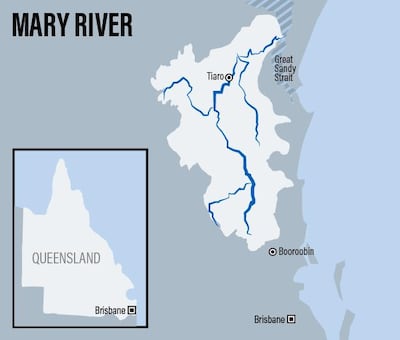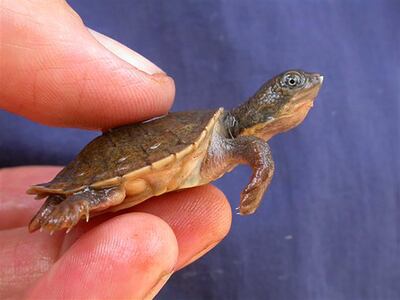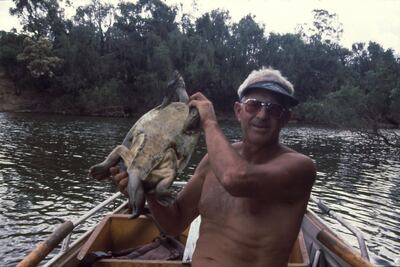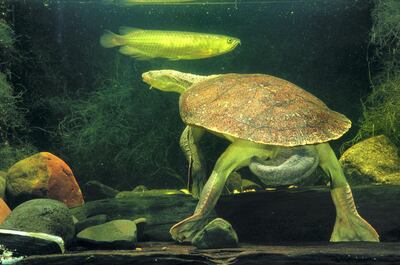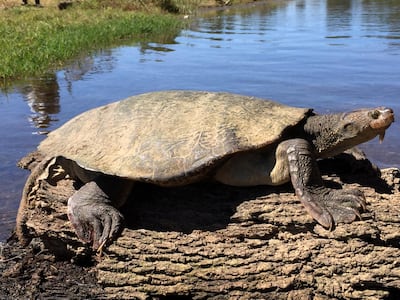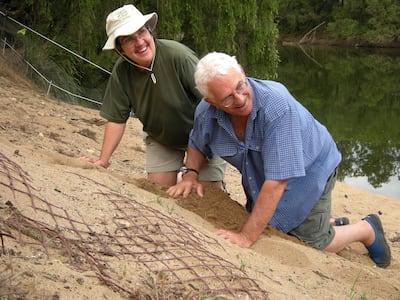There is a town called Booroobin in the hinterland of Australia’s Sunshine Coast, about 90 kilometres from Brisbane, where a river rises and flows north.
It travels 291km and is joined by 19 tributaries before it empties into the Great Sandy Strait. Here, the Mary River’s fresh waters are believed to help sustain seagrass meadows, which feed the herds of grazing dugongs that traverse Queensland’s coast.
The waterway is home to several endangered and vulnerable species, including the ancient Queensland lungfish, a living fossil that has existed since the dinosaurs, as well as the Mary River cod, the Coxen’s fig parrot, the honey blue-eyed fish and several types of frogs and butterflies.
It is also known to be the southern geographical limit for saltwater crocodiles, which are occasionally seen in its lower reaches.
But another reptile brought this particular river to the attention of the world on April 11 last year. Until that day, few people beyond Queensland would ever have heard of Elusor macrurus – commonly known as the Mary River turtle.
The endangered species became an overnight sensation when it was added to the Zoological Society of London's Evolutionary Distinct and Globally Endangered, or Edge, list.
It is highly distinctive and the only species of its genus, having diverged from others about 40 million years ago. The comically anthropomorphic image that accompanied the listing, showing a Mary River turtle with what appeared to be a Mohawk of green algae and spikes protruding from its chin, soon became more commonly known as the “punk turtle” meme.
News editors had a field day: “Punk-Rock Turtle Has ‘Green Hair’, Will Probably Die Alone”; “Endangered reptile: Australia’s ‘punk turtle’ risks being last of the Mohicans.” And on it went.
'Our little mate is in trouble'
Answering calls from journalists all over the world for days after the turtle’s Edge listing was released was Marilyn Connell, who is leading efforts to save the reptile as the co-ordinator of the Tiaro Landcare group.
"It went off. Absolutely went off," she told The National.
As the media hype around the Mary River turtle grew, people began rallying to save it. A group of punk rockers held a benefit gig in the trendy Melbourne suburb of Brunswick, raising conservation funds through the sale of tickets and souvenir badges.
"Hearing the news that the turtle is one of the most endangered reptiles on the planet really sparked an interest for a lot of people," musician Steven 'Stevie' Galati told the ABC.
"The thing I love about the punk rock community is that we all stick together, and now our little mate is in trouble, it's time to stick together for him.”

T-shirts were sold and a fundraising page was set up. By June the same year, just two months after the animal was listed as endangered, actress Cate Blanchett had voiced a puppet of the turtle for a music video launched by the Wilderness Society for its Save Ugly campaign.
This is how the Punk Turtle became the unlikely face of what has been labelled the Earth's sixth mass extinction. From climate change and habitat loss to poaching and pollution, many of the world's creatures are being wiped out at an alarming rate - and turtles are among the worst affected.
According to Edge reptile co-ordinator Rikki Gumbs, recent estimates suggest that as much as 61 per cent of global turtle and tortoise diversity, if not already lost, is under threat from extinction.
“This is a greater proportion of diversity threatened with extinction than any estimates for birds, mammals or even amphibians,” he said.
“Worryingly, freshwater turtles feature prominently on the Edge Reptiles List, indicating that these species are not only threatened but also unique.
“If they are lost, there will be nothing else like them left on Earth.”
And the story of the unique Punk Turtle goes much deeper than the meme.
The son of snake charmers
“What did you want to know about the turtle?” says John Cann when he picks up the phone from his home in Sydney’s Botany Bay.
His voice is one that harks from an older generation of Australians – the folk who come from a time when the lines between the suburbs and the bush were more blurred and the people had to be at least as tough as the critters they lived alongside.
Mr Cann, the man credited for finding the Mary River turtle, is not your typical herpetologist, those who study amphibians and reptiles. His interest in reptiles came from an unconventional upbringing among a family of snake charmers.
His father George was known as the Snake Man of La Perouse and ran a reptile pit at the end of Sydney’s southern tramline, where he would thrill crowds by provoking highly venomous tiger snakes. His mother Essie once worked in a travelling show and was billed as “Cleopatra, Queen of the Snakes”.
Mr Cann followed the family path and became a “snakey” himself, but his interests extended to other reptiles and he became one of Australia’s top turtle experts, writing several important books and naming some of the country’s rarest species. He considers finding and describing the Mary River turtle his proudest achievement in this field.
When he first set eyes on one in the 1960s, the species was not uncommon. In fact, it had been hiding in plain sight – colloquially, they were known as “penny turtles” or “pet shop turtles” or, jokingly, the “petshopeii”.
But despite inhabiting fish tanks in homes across Australia, they remained unclassified.
“As soon as I saw it, I said ‘what’s this?’ I knew it was something different,” Mr Cann said. “I’d never seen anything like it”.
He spent the next 25 years searching for the origins of the turtle, following tips and rumours up and down the country and trying to persuade commercial aquariums to reveal their suppliers.
By the late 1980s, interest was growing and the race was on to be the first to locate and describe the new species. But Mr Cann gained the advantage after he tracked down the fisherman who had been raiding their nests.
After Australia banned the collection and sale of wildlife for pets in the 1970s, effectively ending the pet shop turtle trade, the fisherman had little reason left to withhold the location of their nests.
Once again, the turtle was hiding in plain sight.
“Here’s people all over the country trying to find the turtle, particularly the Queensland Museum, and they were going straight past the Mary River,” Mr Cann said.
The first time he found one in the wild he “got the binoculars on it and as soon as I saw it – I never saw such a large one ever – I knew this was something special.”
In their 1994 description of the species, Mr Cann and co-author John Legler used the Latin name Elusor, meaning elusive – a fitting tribute for a species that took a quarter of a century to locate.
Despite the headlines, it is not the algae hairstyle that make the Mary River turtle so special in Mr Cann’s opinion, but its size. At maturity it is one of the biggest freshwater turtles in Australia, and has an enormous, strangely-shaped tail.
“I knew it would be famous because the tail was unique - so big and long, and it’s the only turtle in the world where the tail vertebrae go right down to a point,” he said.
He may have been a little off the mark about what would endear the public to the turtle, but the characteristics that did turn it into an internet sensation had already played a crucial role in preserving its existence.
In 2006, amid one of the worst droughts on record, the Queensland state government proposed a plan to dam the Mary River. Water reserves were at critical levels and the government was desperate.
Environmentalists and locals argued fiercely against the project, fearing it would be devastating for vulnerable species such as the Queensland lungfish, a living fossil that outlived the dinosaurs and that needs shallow reed grass to lay its eggs.
A dam would also reduce freshwater flow into the ocean, they argued, potentially harming seagrass beds in the Great Sandy Strait - feeding grounds for dugongs.
Amateur photographer Chris Van Wyk was among those against damming the river.
“This is a place where I’d spent countless days of my childhood snorkelling and exploring. I got to swim side by side with living fossils,” he said.
So he did the only thing he felt he could - bought a compact camera with an underwater housing. He started exploring the river by day and night in an attempt to document its extraordinary wildlife.
“I found bioluminescent fungi that light up the forest floor at night. I found endangered frogs that burrow into the river banks,” he said.
“I found giant lungfish that were more than 100 years old. I found endangered cod that were over a metre long, hiding in hollow logs deep beneath the surface.
“I visited the river with snorkelling gear and an underwater camera. I found the turtles I remembered from my childhood and after four days of snorkelling I found a Mary River turtle with algae growing off its head. I knew the photos were special.”
He started handing his photographs out to news outlets, in the hope of drawing attention to the plight of the turtle.
The fight over the dam went on for three years, eventually ending in 2009 when the state was over-ruled by the Australian environment minister Peter Garrett, who blocked its construction under biodiversity laws protecting listed threatened species.
Little did Mr Van Wyk know that his photographs would go viral more than a decade later and be viewed by millions.
'We’re fearful of a collapse'
But the dam project was just one battle in what is shaping up to be a long and difficult fight to save the Mary River turtle. And it had been, at least, a visible enemy. Now the turtles are facing decline, but with no one obvious culprit.
The Mary River turtle is considered Australia’s second most endangered, and is among the 25 most endangered in the world. They can take 25 to 30 years to mature, during which time they seem to be rapidly disappearing.
According to Ms Connell, the number of turtles measuring less than 28 centimetres, or the size of a dinner plate, has plummeted.
“They have very few immatures that we can find and it looks like the population of most of them are large adults,” she said.
“Because they are all long-lived, maybe 100 years, we’re a bit fearful of a collapse. It’s easy to go out and find a Mary River turtle now, and a lung fish, but the majority are big and old and how much longer they will last is the big question.
“This is why we’re trying to do something to reverse or ensure that situation doesn’t get worse.”
The Tiaro Landcare group is already working to protect nesting sites and give hatchlings a head start - an ongoing project that will be expanded with a new grant from the Mohamed bin Zayed Species Conservation Fund.
They are now also trying to find out what happens after the hatchlings enter the water.
“We know now how to increase the survival of the egg and the hatchling life and that’s all very visible to us humans,” Ms Connell said. “But what’s happening in the river, you can’t see. We don’t actually know what’s happening.”
Climate change and predation by feral species such as foxes are among the potential suspects, but as a relatively new-found species, more research is needed to confirm the main threats to the turtle and find ways to improve its chances of survival.
Failing this, there is a real risk the Mary River turtle could join the growing list of unique Australian animals that have vanished entirely since European colonisation.
The rat-like Bramble Cays melomys was recently officially acknowledged as extinct - the first mammal believed to be killed off by climate change. And climate change could be at least one problem facing the Mary River turtle.
Ms Connell said that PhD research by a graduate, Mariana Micheli-Campbell, found that embryos incubated at a higher temperature resulted in smaller hatchlings that did not dive as deep or as frequently as the ones that were incubated at the coolest temperature.
“If they don’t dive deeply and sit on the bottom for a while, they are more likely to get eaten, they are more vulnerable to predators in the river,” Ms Connell said. “That’s a known threat from climate change that can happen every year to every clutch – or many clutches.”
To compound matters, much of Australia’s east coast has been suffering through yet another devastating drought over the past year and it has been a particularly dry summer for the Mary River.
“I dug up most of the clutches the other day and found quite a number of embryos were just dried out,” Ms Connell said. “They had reached full development and were almost ready to hatch.”
A true conservationist, Ms Connell is matter of fact as she relates this story. But the Mary River turtle has become her life’s work and it’s hard to imagine seeing the product of your efforts turn to dust.
Her own path to becoming an advocate for the Mary River turtle happened almost by accident, but it has since taken her around the world meeting reptile experts, community conservation groups, and even the Crown Prince of Abu Dhabi, Sheikh Mohamed bin Zayed, during a visit to the UAE last year.
A botanist by profession, she first learnt about the species when she was doing a vegetation survey along the river - a researcher looking into an endangered turtle had asked to join her.
“None of us had heard of it. That was 1999 and that was the beginning,” she said.
“I started having to learn about zoology and animal conservation rather than vegetation management”.
The Tiaro Landcare group took on the cause and started partnering with universities, raising money by selling turtle-shaped chocolates to support research by graduate students.
The grass-roots conservation work caught the eye of the Mohamed bin Zayed Fund, which has just awarded the group another grant - its third since 2010 - to help search for more nesting sites to bring into the nest-protection programme.
It came after the organisation invited Ms Connell to Abu Dhabi last May to speak about the group’s work and meet the Crown Prince and was one of 55 grants worth $496,773 (Dh1.82 million) handed out.
The fund’s managing director, Razan Khalifa Al Mubarak, said small grants were more flexible and responsive when it came to species conservation projects.

“Small grants empower conservationists to fight extinction, rather than be hampered by the red tape and bureaucracy that often accompanies much larger grants,” she said.
“We believe conservationists are the first line of defence against extinction and getting them in the field with their boots on the ground is best done through small grants.”
Ms Connell said she felt the relationship with the fund had created a connection between communities across the world and it meant a lot for people in the small rural town of Tiaro.
'All of our turtles are in trouble'
While the “punk turtle” stole hearts around the world, plenty of people will still ask why all the fuss for one quirky species of turtle that lives in only one river in Australia - and we became aware of it only in the 1990s.
There are so many animals in danger of extinction.
“It is important for people to realise the current extinction crisis threatens not only the flagship species such as elephants and polar bears, but also the weird, wonderful and usually less known species of this world,” Rikki Gumbs said.
Turtles are widespread and live across many habitats, from the ocean and estuaries to rivers, streams and lakes.
“Across these habitats, turtles vary in their ecology and feeding habits, with some species being herbivorous, some carnivorous, and others omnivorous,” he said.
“This diversity of feeding habits allows turtles to influence the structure of the animal and plant communities around them, fundamentally changing - or maintaining - the ecology of river systems.
“It is vital we conserve these species to maintain the proper functioning of freshwater ecosystems.”
And no species lives in isolation, “not even humans”.
“To conserve an omnivorous freshwater turtle like the Mary River turtle, you must also conserve the plants and animals on which it feeds, and maintain the structure of the river and surrounding habitats to provide suitable habitat for feeding, basking and nesting,” he said. “The conservation of a single species can lead to many aspects of an entire ecosystem being conserved.”
John Cann agrees.
“People today just don’t realise how the numbers are down,” he said. “All of our turtles are in trouble.”
“They are very important. Every animal in Australia is important and they all have their reasons for being there. To think that they are starting to deteriorate… It’s terrible.”

